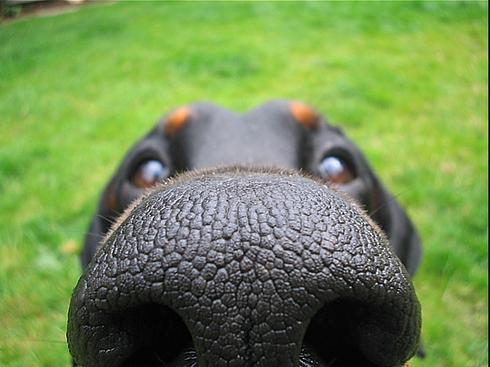Physiological Reactions to Spray
The citronella spray may be effective because it is an extremely unpleasant experience for dogs: Dogs may have between 220 million and two billion olfactory neurons (the sensory neurons lining the nose) but humans have only 2-5 million them (Stafford 2007). Some dogs vomit when the smell is discharged because it so strong and unpleasant to them.
A dog’s nose: Notice the physical differences between his nose and your nose? Imagine the physiological differences! Our sense of smell is not the same as a dog’s sense of smell
Pain
The pain a dog experiences from a shock or the unpleasantness of a spray, can result in redirected aggression and the dog may become anxious and fearful. Pain is the primary eliciting stimulus for aggression (Johson1972).
Equipment Malfunction
The anti-bark collars are prone to misfire (Polsky 1994). A noise from the surroundings, or a dog growling can activate the device. This can lead to disassociation, which can cause increased anxiety, confusion, and aggression.
Lesions
Lesions can develop on the neck if a collar is too tight or has been on for too long. The lesions result from the mechanical abrasion of the electrodes rubbing the skin (Polsky 1994).
 Lesions from incorrect fitting and prolonged wear of a shock collar
Lesions from incorrect fitting and prolonged wear of a shock collar
Denying a Nature Behaviour
Barking is a very common and natural behaviour for a dog. Barking can be a reaction to something, a method of communication and expression. Anti-bark collars deny the ability of a dog to live in a nature way.
Dog barking is common, natural and has a purpose. This dog is barking for attention!
Ignoring Underlining Issues
Anti-barking collars do not encompass the effective training technique of teaching a more appropriate behaviour to replace the undesired behaviour of barking: dogs are simply punished immediately after barking. Dogs’ barking may be motivated because they are anxious about something. It is cruel and will only worsen the fearful temperament of a dog if the barking is motivated by anxiety, such as separation-anxiety or an obsessive-compulsive behaviour (Stafford 2007).
If the motivation for barking was identified, and the owner was willing to address it (through therapy, training and/or management modifications) then anti-barking collars wouldn’t be necessary. Punishment alone is not the best way to treat barking. It is cruel and will only increase the fearful behaviour of a dog if the barking is motivated by anxiety, such as separation-anxiety or an obsessive-compulsive behaviour (Stafford 2007).


